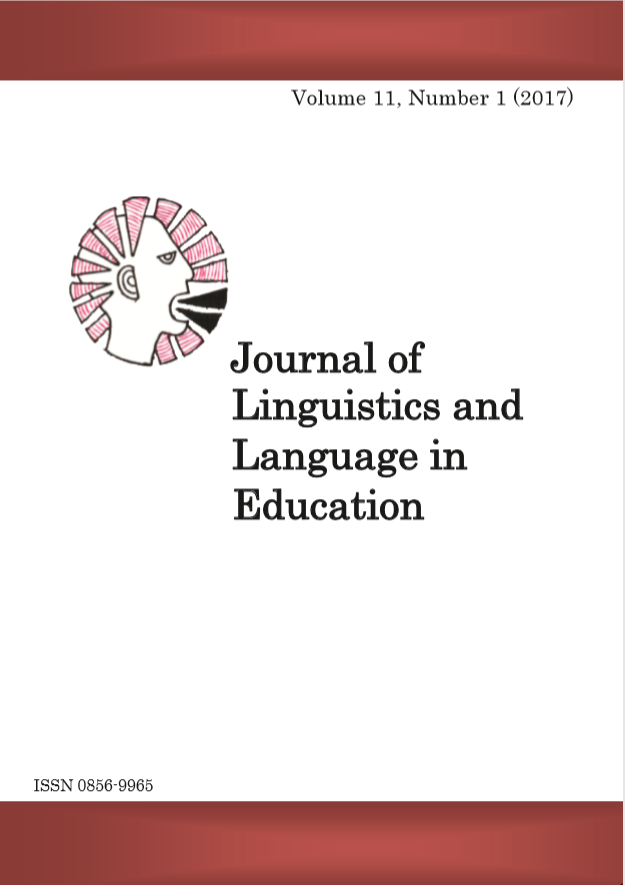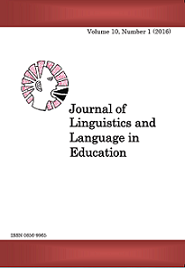Onomatopoeic Ideophone-gesture Couplings in Kuria
Abstract
Abstract
There has been a general consensus that ideophones tend to occur in synchrony
with depictive gestures in a manner that the two enhance each other. However,
there have been conflicting views with regard to this synchrony, particularly
withregard toonomatopoeic ideophones. While several studies reveal that
onomatopoeic ideophones are merely simplistic and rarely accompanied by
depictive gestures, analytical studies to ascertain these findings are scant.
However, data from Kuria show that onomatopoeic ideophones are not only
numerous in number but also accompanied by depictive gestures by 68%.
Findings also reveal that onomatopoeic ideophones in Kuria are divided into
two categories: those with sound modality alone and those that have multiple
modalities with sound being a dominant modality. This paper argues that in
establishing modality, native speakers ' intuition and body language, as
reflected in verbal and gestural information, should be taken into account. The
paper concludes that the Kuria onomatopoeic ideophones are accompanied by
depictive gestures at a higher rate than previously reported in the literature.
Key words: ideophones,depiction,depictive gestures, onomatopoeic ideophones,
modality, Kuria
References
References
Diffloth, G. (1972). Notes on Expressive Meaning. Chicago
Linguistic Society, 8: 440 €“447.
Dingemanse, M. (2011a). The Meaning and Use of Ideophones in
Siwu. Published PhD Thesis, Radboud University, The
Natherlands: Radboud University.
Dingemanse, M. (2012). Advances in the Cross-linguistic Study of
Ideophones. Language and Linguistics Compass, 6: 654 €“672.
Dingemanse, M. (2013). Ideophones and Gesture in Everyday
Speech. Gesture, 13(2): 143 €“165.
Dingemanse, M. (2015). Folk Definitions in Linguistic Fieldwork. In
J. Essegbey, B. Henderson, & F. Mc Laughlin (eds.). Language
Documentation and Endangerment in Africa. Amsterdam:
Benjamins: 215 €“238.
Fortune, G. (1962). Ideophones in Shona: An Inaugural Lecture
Given in the University College of Rhodesia and Nyasaland on
April 1961. London: Oxford University Press.
Güldemann, T. (2008). Quotative Indexes in African Languages: A
Synchronic and Diachronic Survey. Berlin: Mouton de
Gruyter.
Hatton, S.A. (2016). The Onomatopoeic Ideophone-Gesture
Binagi Daudi Rioba|83
Relationship in Pastaza Quichua. Published M.A. (Linguistics)
Dissertation, Department of Linguistics and English
Language, USA: Brigham Young University.
Hinton, L., Nichols, J. & Ohala, J.J. (eds.). (1994). Sound Symbolism,
Cambridge: Cambridge University Press.
Kita, S. (1993). Language and Thought Interface: A Study of
Spontaneous Gestures and Japanese Mimetics. Published
PhD Thesis, Department of Psychology, Department of
Linguistics, USA: University of Chicago.
Kita, S. (1997). Two-dimensional Semantic Analysis of Japanese
Mimetics. Linguistics, 35: 379 €“415.
Kroeger, R. (2016). Folk Definitions of Korean Ideophones. San Diego
Linguistic Papers, 6: 66 €“121.
Lusekelo, A. (2013). Word Categorization in African Languages: The
Case of Ideophones in Swahili: In W. Adegbite, A. Ogunsiji, &
O. Taiwo (eds.). Linguistics and the Glocalisation of African
Languages for Sustainable Development, Nigeria: Universal
Akada Books Limited: 370 €“389.
McGregor, W. B. (2002). Verb Classification in Australian
Languages. Berlin: Mouton de Gruyter.
Moshi, L. (1993). Ideophones in Kivunjo-Chaga. Journal of Linguistic
Anthropology, 3(2): 185 €“216.
Mreta, A. Y. (2012). Ideophones in Chasu. Journal of the Korean
Association of African Studies, 36: 3 €“50.
Nuckolls, J. B. (1996). Sounds like Life: Sound-Symbolic Grammar,
Performance, and Cognition in Pastaza Quechua. New York:
Oxford University Press.
Nuckolls, J. B. (2000). Spoken in the Spirit of Gesture: Translating
Sound Symbolism in a Pastaza Quechua Narrative. In J.
Sherzer & K. Sammons (eds.). Translating Native Latin
American Verbal Art. Washington, DC: Smithsonian Press:
€“251.
Nuckolls, J. B. (2001). Ideophones in Pastaza Quechua. Typological
Studies in Language, 44: 271 €“286.
Reiter, S. (2012). Ideophones in AwetÃ. Published PhD thesis,
Universität Köln.
Samarin, W. J. (1971). Survey of Bantu Ideophones. African
Language Studies, 12: 130 €“168.
| Onomatopoeic Ideophone-gesture Couplings in Kuria
Downloads
Published
Issue
Section
License
Copyright © by Department of Foreign Languages and Linguistics, University of Dar es Salaam
All rights reserved. No part of this publication may be reproduced or transmitted in any form or by any means, electronic or mechanical, including photocopying, recording, or any information storage or retrieval system, without permission in writing from the publisher, except for short extracts in fair dealing, for research or private study, critical scholarly review or discourse with an acknowledgement.



